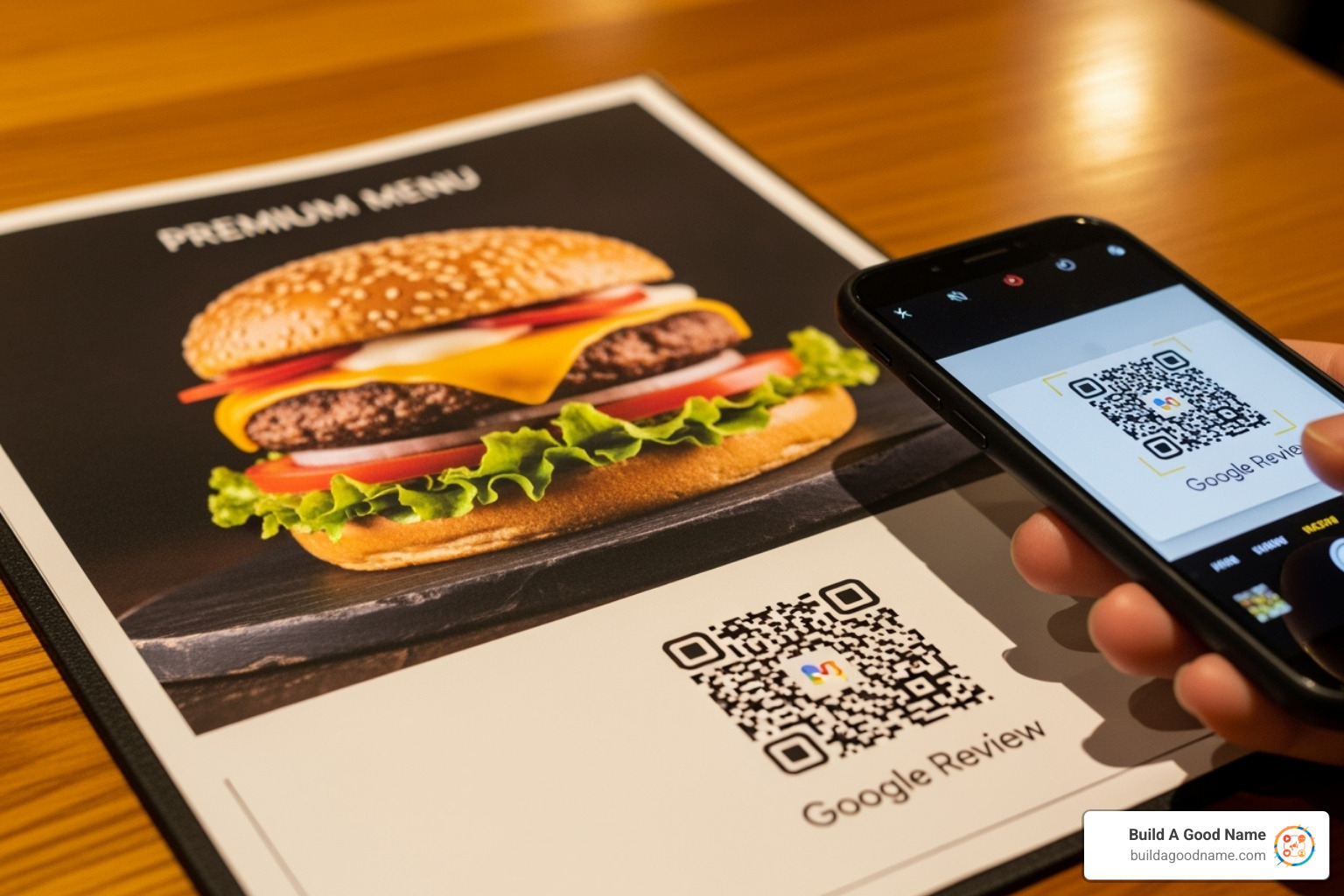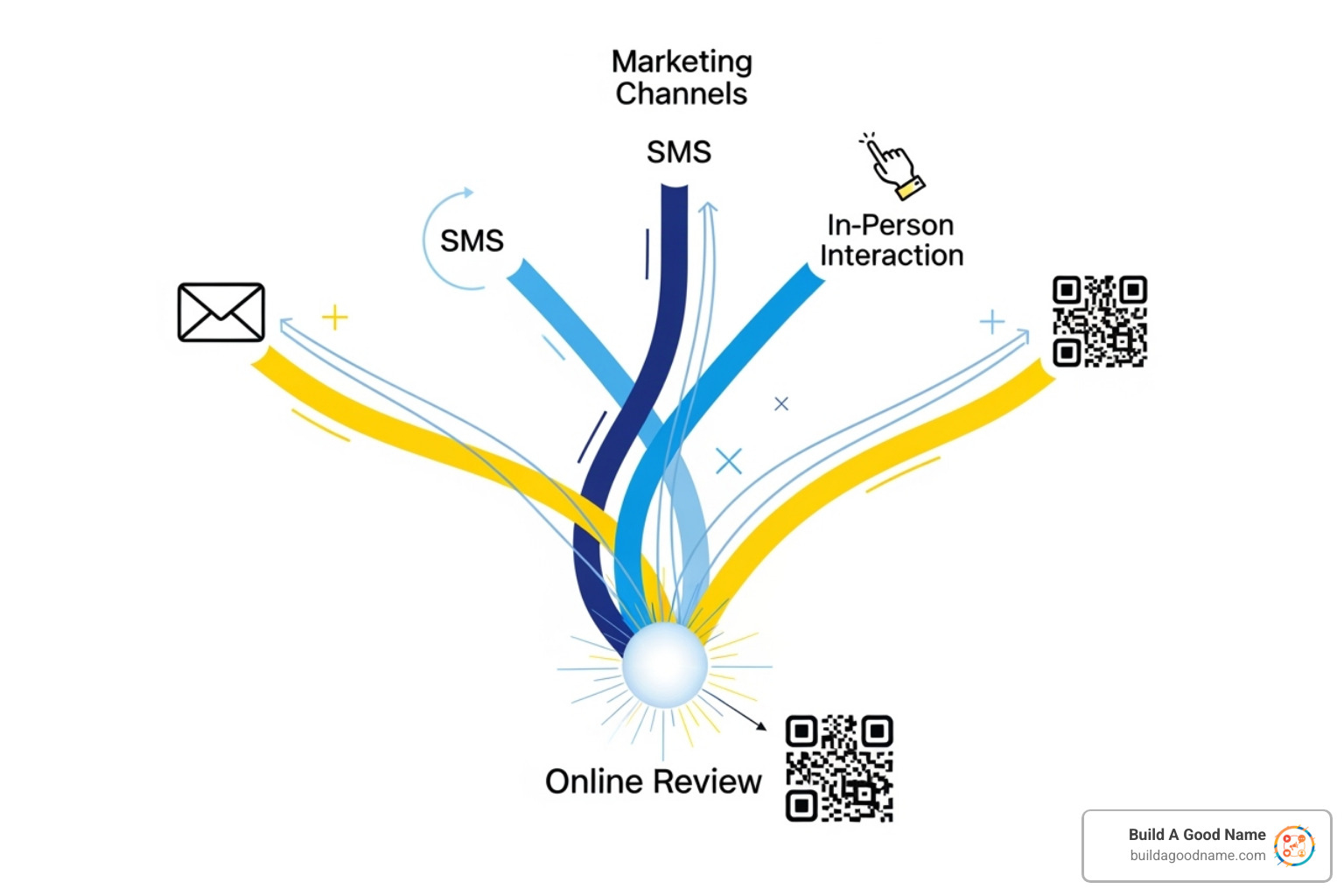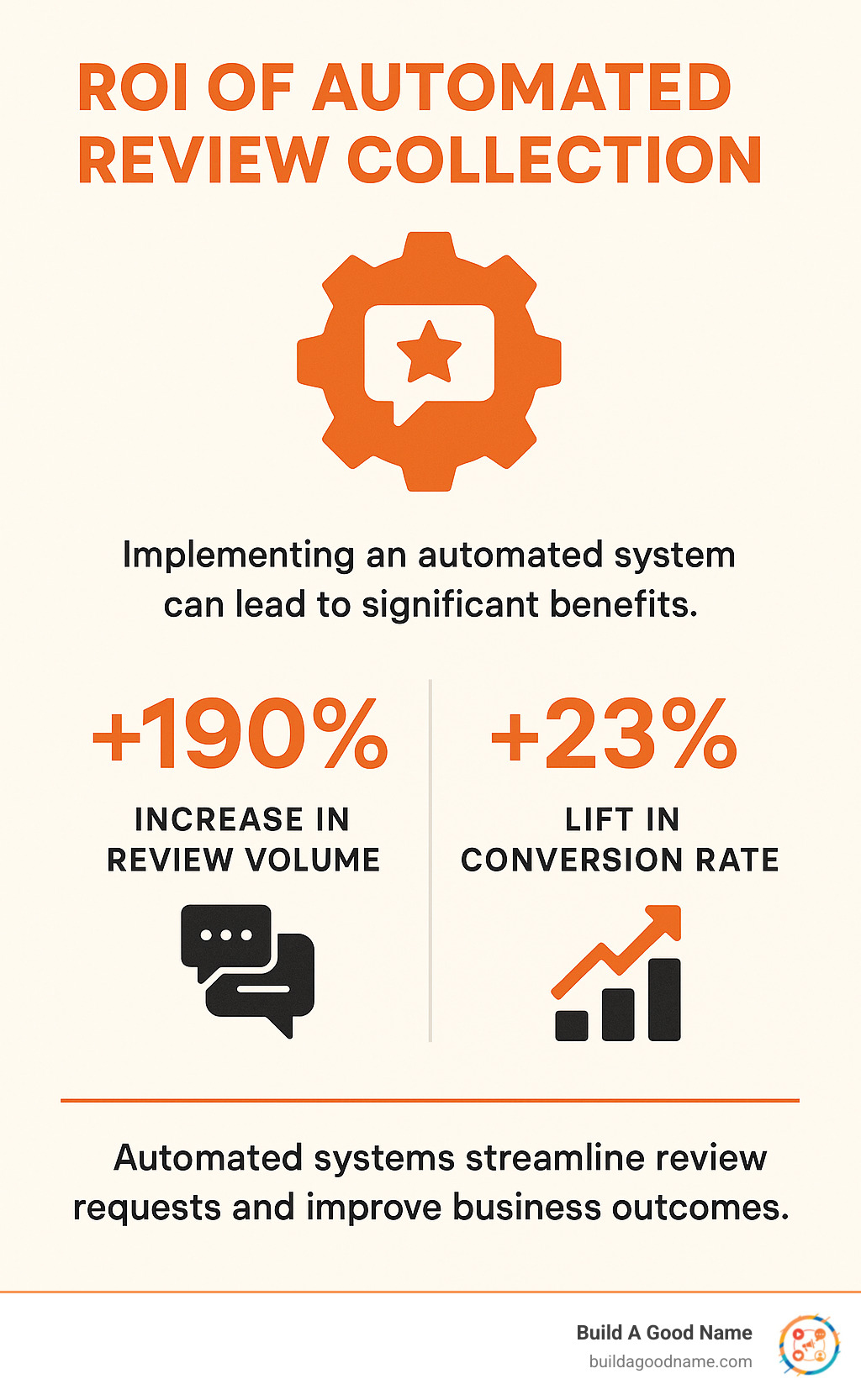Why Your Business Needs a Review Strategy
The Power of a Five-Star Rating: Why Google Reviews Are Non-Negotiable
Online reviews are no longer a “nice to have.” When a prospect looks you up, those stars are often the first—and sometimes only—thing they notice. In seconds, they decide whether to click or keep scrolling.
85% of consumers trust online reviews as much as personal recommendations, and 75% say star ratings directly influence which company they choose. A five-star average isn’t just ego-boosting; it’s revenue-critical. A steady stream of positive feedback becomes round-the-clock social proof, often doubling inquiries for businesses that actively ask for reviews with a simple google review maker link.
Although 88% of customers say they’d write a review, most never do unless you make it effortless. That gap is the opportunity smart businesses seize.
How Reviews Directly Impact Your SEO and Visibility
Every new review is fresh, keyword-rich, user-generated content that Google happily indexes. More reviews mean more relevant phrases and stronger local signals. Consistent “review velocity” is a known factor in Local Pack rankings, and listings that display star ratings earn higher click-through rates. That extra engagement feeds Google even better signals, creating a virtuous cycle. For details, see our guide on Google Online Reputation Management.
The Shocking Stats Behind Customer Trust
- 78% of people trust online reviews as much as friends or family.
- 63% are more likely to buy from a site that shows user reviews.
- 48% only pay attention to reviews written within the last two weeks.
- The average shopper reads 10 reviews before feeling comfortable.
Translation: you need a regular flow of fresh, visible feedback, not a handful of outdated comments. Studies show that displaying at least 50 positive reviews can lift sales by roughly 5%. Stars sell—so put them where customers can see them.
Decoding the Tools: What Is a Google Review Maker?
Picture this: a customer just had an amazing experience at your restaurant. They’re walking out the door, still talking about how great the service was. This is the perfect moment to ask for a review, right? But then you say, “Could you please go to Google, search for our business, find our profile, and leave us a review?”
Watch their enthusiasm deflate. It’s not that they don’t want to help – it’s just that the process sounds complicated and time-consuming. By the time they get to their car, they’ve already forgotten about it.
This is exactly the problem that a google review maker solves. Instead of sending customers on a digital scavenger hunt, these tools create a direct path from your request to Google’s review form. Think of it as building a bridge between your customer’s good intentions and actually leaving that five-star review.
The magic happens behind the scenes. Google’s review URLs are notoriously complex – they’re filled with long strings of numbers and characters that look like someone fell asleep on their keyboard. A google review maker takes this messy URL and transforms it into something clean and clickable. Even better, many tools can turn these links into QR codes that customers can simply scan with their phones.
What is a Google Review Maker or Link Generator?
A Google Review Link Generator is your digital assistant for review collection. It finds your business in Google’s vast system and creates a direct link that takes customers straight to your review page. No searching, no scrolling, no confusion – just click and review.
Here’s how simple it works: you enter your business information, and the tool does the detective work. It locates your business’s unique identifier in Google’s database (called a Place ID) and uses that to build a direct review link. The whole process takes about 30 seconds, but it can transform your review collection efforts.
The real beauty is in what happens next. Instead of giving customers vague instructions like “find us on Google,” you can send them a text message with a direct link. Or print a QR code on your receipts. Or add a button to your website. Suddenly, leaving a review becomes as easy as clicking a link.
Google provides instructions for creating these links manually, but it’s a bit like changing your car’s oil when you could just drive to a quick-lube place. You can do it yourself, but why would you when automated tools make it so much easier?
The Technical Side: Understanding Place ID, CID, and FID
Don’t worry – you don’t need to become a tech expert to use these tools effectively. But understanding the basics can help you appreciate why a google review maker is so valuable.
Every business in Google’s system gets a unique fingerprint called a Place ID. It’s like a social security number for your business – a string of characters that Google uses to identify your specific location among millions of others. This Place ID is what most review tools use to create your direct links because it’s reliable and doesn’t change.
You might also encounter something called a CID (Customer ID), which is that really long number you sometimes see in Google Maps URLs. It’s another way Google identifies your business, and some tools use this instead of Place ID. Both work fine – they’re just different routes to the same destination.
Then there’s the FID (Feature ID), which is specifically related to reviews. When you see a link that takes you directly to the review form (not just your business profile), it’s probably using FID in combination with other identifiers.
The technical complexity is exactly why these tools exist. Instead of trying to steer Google’s various APIs and identifier systems yourself, you can use a tool that handles all the backend work. It’s like having a translator who speaks fluent “Google” so you don’t have to learn the language yourself.
Most google review maker tools handle this complexity automatically. You focus on running your business, and the tool focuses on making it easy for customers to share their experiences. That’s a pretty good deal, considering the alternative is spending hours trying to figure out Google’s technical documentation.
Expanding Your Toolkit: From Simple Links to Smart Solutions

Here’s where things get interesting. Once you’ve mastered the basics of creating review links, you can start thinking bigger. The most successful businesses don’t just ask for reviews – they make it irresistibly easy for customers to leave them.
Modern google review maker tools have evolved way beyond simple link generation. They’re now sophisticated systems that can create branded QR codes, display your reviews beautifully on your website, and even send automated review requests at just the right moment. At Build A Good Name, we’ve watched businesses triple their review collection rates when they stop relying on manual requests and start using smart automation.
The secret is understanding that your customers are different. Some love getting a friendly email reminder a few days after their purchase. Others prefer scanning a QR code right on the spot while they’re still excited about their experience. The smartest businesses use multiple approaches because they know that giving customers options dramatically increases their chances of getting feedback.
Think about it from your customer’s perspective. They just had a great experience with your business, but life gets busy. If you wait three days to ask for a review via email, that positive feeling might have faded. But if you give them a QR code they can scan immediately? That’s when you capture their enthusiasm at its peak.
The Magic of QR Codes for Instant Feedback
QR codes have made a huge comeback, and for good reason. They bridge the gap between your physical business and the digital world where reviews live. When a customer can scan a code and leave a review in under 30 seconds, you’ve eliminated almost every excuse for not doing it.
The timing aspect is crucial here. Customer satisfaction decreases over time, and so does their willingness to leave reviews. A QR code on your receipt or table tent captures them while they’re still glowing about their experience. It’s like striking while the iron is hot.
The versatility of QR codes is remarkable. You can print them on receipts and invoices for service businesses, business cards and flyers for networking events, table tents and counter displays for restaurants, packaging and shipping materials for e-commerce, and even include them in email signatures as images.
For businesses implementing Customer Review Automation, QR codes serve as the perfect bridge between offline interactions and online feedback. They’re especially powerful for brick-and-mortar businesses that want to capture reviews from walk-in customers who might otherwise slip away without leaving feedback.
Using a Google Review Widget for On-Site Social Proof
A Google Review Widget is like having your happiest customers standing in your lobby, ready to tell everyone who walks by how great you are. Instead of hoping potential customers will hunt down your Google Business Profile to read reviews, you bring those glowing testimonials directly to your website.
The psychology here is powerful. When visitors land on your site and immediately see positive reviews from real customers, it builds instant trust and credibility. It’s social proof working in real-time, and it can be the difference between a visitor who bounces and one who becomes a customer.
Modern review widgets are sophisticated tools that display your most recent reviews automatically, filter to show only your best ratings, include reviewer photos and your responses, match your website’s design perfectly, and update in real-time as new reviews come in.
For businesses serious about conversion optimization, widgets are essential. They provide fresh, user-generated content that search engines love, and they turn your positive reviews into a 24/7 sales tool. When you’re Sharing Google Reviews on Social Media, widgets ensure that same social proof is working hard for you on your own website too.
The best part? Once you set up a review widget, it works automatically. Every new positive review becomes another reason for visitors to trust your business and make a purchase.
Your Strategy: How to Effectively Use a Google Review Maker

Here’s the truth about google review maker tools: they’re only as good as the strategy behind them. You can have the slickest link generator in the world, but if you’re not using it systematically, you’re missing out on most of its potential.
The businesses that see real results treat review collection like any other important business process. They don’t just ask for reviews when they remember to – they build it into their customer journey. This means having multiple touchpoints where customers naturally encounter review requests, from automated email follow-ups to QR codes on receipts.
Think about your customer’s experience from start to finish. Where are the moments when they’re most satisfied? Right after a great meal? When they see their newly cleaned carpets? The day their website goes live? These are your golden opportunities to ask for feedback.
The timing factor is crucial here. Research consistently shows that customers are most likely to leave reviews within 24-48 hours of their experience. After that window closes, getting reviews becomes much harder. This is why successful businesses use automated systems that trigger review requests based on customer actions, not calendar reminders.
But here’s what many business owners get wrong: they think asking for reviews is about them. It’s not. It’s about helping other customers make confident decisions. When you frame your request this way, customers are much more likely to respond positively.
Best Practices for Asking Customers for Reviews
The difference between businesses that struggle to get reviews and those that collect them consistently often comes down to how they ask. There’s definitely an art to making review requests feel natural and valuable rather than pushy or desperate.
Personalization is everything. Generic review requests feel like spam, and customers treat them accordingly. When you use your customer’s name and reference their specific experience, it shows you actually care about their individual journey with your business. “Hi Maria, thanks for trusting us with your wedding flowers” hits differently than “Dear Valued Customer.”
Explain why their review matters. Don’t just ask for a review – help customers understand the impact. When you say “Your feedback helps other couples plan their perfect wedding day,” you’re giving them a reason to invest their time. People want to help others, especially when they’ve had a positive experience themselves.
This is where your google review maker becomes invaluable. Make the process ridiculously easy. Don’t ask customers to search for your business or steer Google’s interface. Give them a direct link or QR code that takes them exactly where they need to go. The fewer steps between your request and the review form, the more reviews you’ll collect.
Timing varies by industry, but the principle remains the same – ask when the positive experience is fresh. Restaurants should ask while customers are still enjoying their meal or immediately after. Service businesses like contractors should wait until the project is complete and the customer can see the results. Online retailers should trigger requests when products are delivered and customers have had time to use them.
For detailed guidance on crafting review requests that actually work, check out our guide on How to Write a Good Review. And remember – collecting reviews is only half the battle. Responding to them is equally important, which is why our Respond to Google Reviews guide is essential reading.
Choosing the Right Google Review Maker for Your Needs
Not every google review maker tool is right for every business. The key is matching the tool’s capabilities to your actual needs and growth plans. Start by honestly assessing where you are now and where you want to be in the next year or two.
Free tools work well for testing the waters. They typically offer basic link generation and maybe simple QR code creation. If you’re a small business just getting started with review collection, these can help you understand the process without any financial commitment. But they usually have limitations that become frustrating as your needs grow.
Paid software becomes worthwhile when you’re ready to scale. The automation features, analytics, and integration capabilities can dramatically increase your review collection rates. Most businesses find that the investment pays for itself quickly through improved online reputation and increased customer trust.
Automation is where the real magic happens. Tools that can automatically send review requests based on customer actions – like completing a purchase or finishing a service appointment – remove the human error factor. They ensure every customer gets asked for a review at the optimal time, without you having to remember or manage the process manually.
Analytics and reporting help you optimize your approach. Look for tools that track important metrics like how many requests are delivered, how many customers click through to the review page, and how many actually leave reviews. This data helps you refine your timing, messaging, and methods.
At Build A Good Name, we’ve designed our Review Management Software to address all these needs in one integrated platform. Our system doesn’t just generate review links – it automates the entire process from initial request to follow-up, while providing detailed analytics to help you understand what’s working and what isn’t.
The most important factor is choosing a solution that grows with your business. What works for a single-location coffee shop might not scale for a multi-location franchise. Consider your current needs, but also think about your growth plans. It’s better to invest in a platform you can grow into than to outgrow a simple tool and have to start over.

Frequently Asked Questions about Google Review Tools
Let’s address the most common questions business owners have about using google review maker tools. These are the real-world concerns we hear from clients every day, and getting clarity on these points can make the difference between success and frustration with your review collection efforts.
How do I get my direct Google review link for free?
Getting your direct Google review link is actually simpler than most people think. You have two main options, and both are completely free.
The manual method involves logging into your Google Business Profile dashboard and clicking the “Get more reviews” button. This generates a direct link that you can copy and share with customers. It works perfectly fine, but the URL is usually long and unwieldy – not exactly something you’d want to text to a customer or print on a business card.
The easier approach is using a free google review maker tool. These tools do the heavy lifting for you by automatically finding your business’s unique Place ID and creating a clean, shareable link. Many also generate QR codes at the same time, giving you multiple ways to share your review request.
At Build A Good Name, our free tool streamlines this entire process. You simply enter your business name, and we handle all the technical details behind the scenes. The result is a professional-looking link that’s easy to share across all your marketing channels.
Can I get in trouble for using a Google review maker?
This is probably the most common concern we hear, and the answer is reassuring: absolutely not. Using a google review maker tool is completely within Google’s guidelines because these tools don’t manipulate or fake anything – they simply create a more convenient path to your existing review page.
Think of it like putting up a sign that says “Reviews this way” instead of making customers wander around looking for the right door. You’re making the process easier, not changing the actual review system.
However, there are some practices you should avoid. Review gating – where you only ask happy customers for reviews – is against Google’s policies. So is offering incentives like discounts or freebies in exchange for reviews. The key is treating all customers equally and letting them share their honest experiences.
Google’s policies focus on authenticity and fairness. As long as you’re giving every customer the same opportunity to leave a review, you’re playing by the rules. The tools themselves are just making that opportunity more accessible.
How do I respond to the reviews I get?
Once you start collecting reviews with your google review maker tool, responding to them becomes your next priority. This is where many businesses drop the ball, but it’s actually one of the most important parts of reputation management.
You can respond to reviews directly through your Google Business Profile dashboard. Every review deserves a response – both positive and negative ones. This shows potential customers that you’re engaged and care about feedback.
For positive reviews, keep your responses warm and personal. Thank the customer by name if possible, and mention something specific about their experience. This shows you’re paying attention, not just copy-pasting generic responses.
Negative reviews require more finesse. Stay professional, acknowledge their concerns, and offer to resolve the issue offline. Never get defensive or argumentative in public responses. You’re not just responding to that one customer – you’re showing everyone else how you handle problems.
The timing matters too. Try to respond within 24-48 hours when possible. Quick responses show you’re actively managing your reputation and care about customer feedback.
For detailed guidance on crafting effective responses, check out our Best Responses to Google Reviews guide. It covers everything from tone to specific phrases that work well in different situations.
Conclusion: Automate and Lift Your Online Reputation
Your journey with a google review maker doesn’t end with generating a simple link. The businesses that truly succeed understand that collecting reviews is just the beginning of building a reputation that drives real growth.
Think about where you started reading this guide. Maybe you were frustrated that customers weren’t leaving reviews, or perhaps you were manually asking for feedback and getting disappointing results. The truth is, most businesses struggle with review collection because they’re making it too hard for customers and too time-consuming for themselves.
The solution isn’t just about having the right tools – it’s about creating systems that work without you. When you can automatically send review requests after every transaction, respond to feedback intelligently, and showcase your best reviews across all your marketing channels, you’re not just collecting testimonials. You’re building a reputation machine that works around the clock.
Simplifying the process is absolutely key, but automation is where the magic happens. Manual review collection might work when you’re starting out, but as your business grows, you need systems that scale with you. This is exactly why we built Build A Good Name’s platform to handle everything from initial requests to intelligent responses.
The most successful businesses we work with have moved beyond basic google review maker tools to comprehensive reputation management. They’re using AI for Business Reviews to craft personalized responses, identify patterns in customer feedback, and even predict potential reputation issues before they become problems.
Here’s what we’ve learned from helping thousands of businesses transform their online reputation: the companies that treat reviews as a strategic business asset consistently outperform those that see them as an afterthought. When you systematically collect feedback, respond thoughtfully, and showcase your reputation strategically, you create a competitive advantage that’s hard to replicate.
Your online reputation isn’t something that just happens to you – it’s something you actively build and control. The tools exist to make this process systematic and scalable. The question isn’t whether you should invest in a review strategy, but how quickly you can implement one that drives measurable results.
Ready to take control of your online reputation? Start with the fundamentals of review collection, but don’t stop there. Accept automation, leverage the technology, and watch as your improved reputation attracts more customers, generates better reviews, and drives stronger business growth. Learn more about how to Generate More Google Reviews and transform your online presence starting today.



